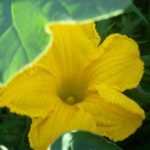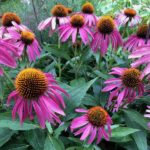New Moon Greetings – May 26, 2025
Discovery of Fiber Plants

For the last few years I have been intrigued with spinning fibers into usable thread and imagining how our ancestors first pieced this skill together. This all began when I grew flax to process into linen. You can read about that experience here, but I have since realized that some of my early musings were incorrect.

When I wrote some of my original posts, it was hard for me to understand how our ancestors stumbled upon the process of extracting fiber from the plants. If you grow flax in your ornamental bed, you know that it has beautiful blue flowers but a very thin willowy stalk. Nothing about this plant suggests that there is fiber hidden inside. In order for the fiber to appear the flax stems need to be soaked in water (retting) so that bacteria can eat away the external stem. However, if you leave the stems in the water too long, the fiber itself deteriorates. I was fascinated by how our ancestors figured this out.

But as I have begun to pay more attention to the fiber plants in my yard (nettles, milkweed, hops), I saw that sometimes the retting process takes place naturally over the winter. In the spring you might find stalks falling over and cracked, revealing the fiber inside. Of course, this process of discovery likely took humans many years to piece together, but the fiber inside the stalk does reveal itself. I imagine some curious human pulling the fibers from the stalk to investigate and play with. At some point they discovered that gently twisting the fibers together makes them quite strong and almost impossible to break. This had to be an a-ha moment that was repeated all over the world.
Immersed in Spinning

I don’t live near any other spinners and so am dependent on phone consultation with my friend Cheryl (a fiber wizard), and books and videos – of which there are plenty. The focus of most of this information is of course on the mechanics of spinning: types of fibers, techniques, and tools. But if you go far enough down the rabbit hole there are other aspects of spinning that pop up. They include social justice and mindfulness.
Spinning and Social Justice
I have not really made anything with the yarn that I’ve spun. Some of that is because my yarn is still uneven, but I also just enjoy spinning. Cheryl has assured me that I am in good company because Mahatma Ghandi spun yarn and just gave what he spun away.

So I mistakenly assumed that spinning was a kind of meditation for Ghandi. And although that is partially true, it is not the whole story. Ghandi saw spinning as a way to advocate for change. In Ghandi’s quest to help India secure its freedom from Great Britian, he promoted the idea of Indians spinning and weaving their own fabric and clothes. He encouraged self-sufficiency with clothing production as a boycott of British goods. This social justice movement became a source of unity among Indians. It was a way they could collectively resist the British. I only learned this part of the story recently and it is a beautiful reminder that people united can overcome oppression.
The Here and Now of Spinning

But Ghandi also recognized the mindfulness aspects of spinning. He spun for an hour each morning and encouraged others in his spiritual community to do the same. Spinning fiber enables focus, a rhythm that can be synced with the breath, and an awareness of the here and now as fiber slips through our fingers and transforms into thread and yarn. It is a soothing practice that can create calmness and joy. I especially like the tactile nature of the activity. It is also worth contemplating that this practice is thousands of years old, and in a way, there is a connection to all the spinners who came before us.
The Spinning Journey

If I was starting over, I’d spend more time working with wool to become proficient with spinning techniques before moving onto flax. My excitement about growing fiber in my garden overrode any advice that flax was a harder fiber to spin. Flax is stiffer than wool and requires water to be added as you spin. At the beginning it felt like I needed three hands – one for the spindle, one for the fiber, and one to add water. So, it can be a little more challenging to begin with flax.
And although it is great to have so many videos and websites devoted to spinning, you can get lost in the minutia. Honestly, spinning is a straightforward process. We take fiber, put a twist in it, and it becomes yarn or thread. We could actually just twist fibers between our fingers (which is how this whole thing got started thousands of years ago), but that would take a long time to create thread.

Spindles speed up the process and that is where the “cereal aisle phenomenon” kicks in. There are way too many choices and techniques. This is a modern problem because a few hundred years ago we would have learned the technique within our communities. There would have been one particular type of spindle and a few choices of fiber. So if you are thinking about started to spin, watch a few videos and then just go with something that calls to you. Don’t overthink it!

What’s Next
I’m not sure when I will move from spinning to creating something wearable or usuable with my fibers. One of my goals this summer is to simply spin thinner flax fiber (linen thread). The other goal is to harvest, process, and spin hops and nettles from my garden. I had hoped to get to that last year, but it didn’t happen so I am stating it clearly as a goal here which will keep me focused.
Whatever happens will be perfect because the spinning itself is a beautiful connection to the earth, my garden, and the ancestors.
About this Blog Post & and Qigong Practice

This post is part of my lunar blog series. I post each new moon as it is a great time to begin projects and set intentions with the increasing light. Topics are related to related to plants and ideas featured in my book, Growing Mindful. . Other topics are related to mindfulness, gardens, qigong, and intentional living. For more details and a list of past lunar blog posts, click here.
About Qigong – I lead qigong at Bluff Lake Nature Center in Denver on the last Sunday of each month. You can find the schedule in announcements on the home page. I have also partnered with other graduates of the IIQTC (Institute of Integral Qigong and Tai Chi) to offer virtual HeART of Body Compassionate Self Care Practice Circles based on qigong and tai chi. Check out the information here: Global Healing Circles or contact me if you need more information.


